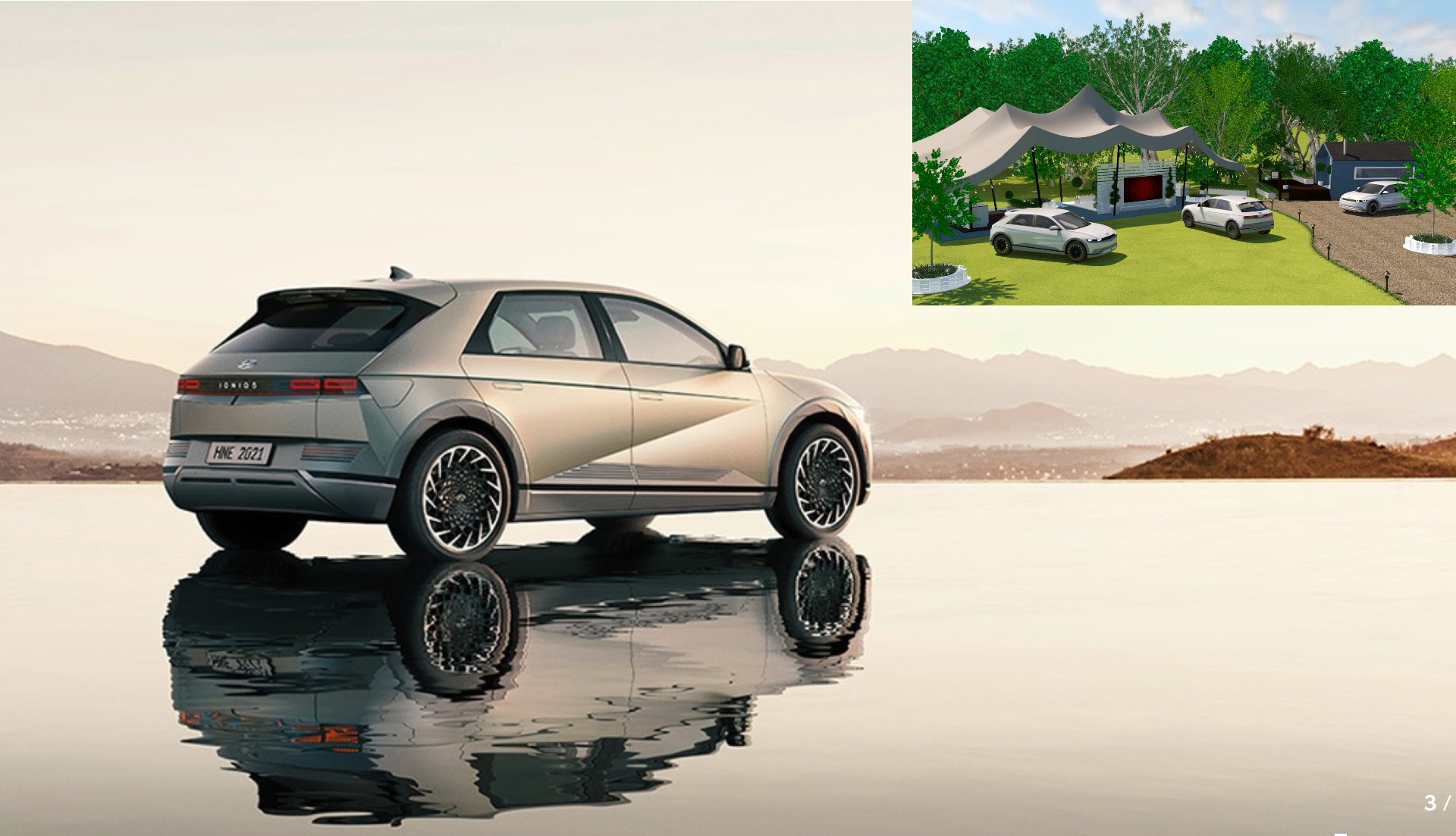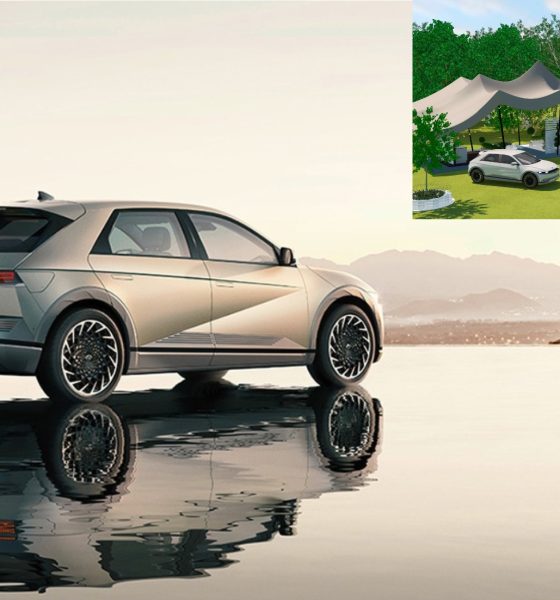

News
Hyundai opens first car-powered hotel with the IONIQ 5
Hyundai opened a hotel powered by its IONIQ 5 all-electric vehicle. The car-powered vacation spot is located in the countryside of the United Kingdom.
Hyundai Hotel is a collaboration between the Korean automaker and broadcast/critic Grace Dent. The hotel will utilize the IONIQ 5’s Vehicle-to-Load (V2L) technology to power the entire facility. The car has a V2L port at its charging port.
The IONIQ 5 has at least two battery options: the Standard-range 58kWh pack and the Long-range 72.6 kWh pack. It is unclear which battery option powers Hyundai Hotel. Hyundai stated that V2L could supply up to 3.6 kW of power. The Korean car manufacturer said the IONIQ 5 could charge high-power electric equipment using a converter. The car can also provide power while it’s turned off.
“We’re looking for unique, memorable stays more now than ever and this is a delicious blend of innovation, luxury and comfort that gets you thinking. With power coming from the car, where could Hotel Hyundai pop-up next?” comments Grace Dent.
The entire concept of the hotel is based on research commissioned by Hyundai. Approximately 2,000 vacationers participated in the research. More than 55% of the participants noted that the cost-of-living crisis made them reevaluate their vacation plans.
About 44% of vacationers in the research said they would likely go on more staycations in 2023 compared to 2022. Around 31% of the participants highlighted that staycations were better for shorter vacations or breaks. Three out of ten vacationers noted that the UK countryside was a good place to enjoy their mini-breaks.
Hotel Hyundai is situated in Essex, an hour away from central London. Its location seems to be ideal for short breaks or mini vacations. The car-powered hotel is centered around a high-end luxury cabin by Colemans Farm. Everything in the cabin is powered by the IONIQ 5’s V2L technology.
“Our award-winning IONIQ 5 is able to power Hotel Hyundai using its V2L feature, where an adapter from the car provides a socket which domestic appliances can be plugged into. The whole experience demonstrates the practicality of this pioneering technology, and we hope the concept inspires more people to go off grid,” said Hyundai Motor UK’s Managing Director Ashley Andrew.
Hyundai’s award-winning all-electric vehicle also powers the IONIQ 5 coffee lounge at the hotel’s bar and restaurant. It also powers the projector, speakers, and popcorn machine at the hotel’s cinema.
Hotel Hyundai is operational for only 14 nights between October 19 and November 5. It will be open from Wednesday to Sunday. People interested in staying at the hotel have a chance to win a stay at the car-powered hotel through: www.kiphideaways.com/hideaways/hotel-hyundai. The competition will run from October 6 to October 19.
For those who don’t get a chance to stay at Hotel Hyundai, there might be hope in the future. The car-powered hotel might pop up somewhere else in the future.
“I hope this three-week pop-up hotel is just the start for this concept of a car plugging in and powering a luxury experience like this. I’m predicting that guests will be hoping that his amazing hotel and the full experience it offers might be here again in 2023,” teased Dent.
The Teslarati team would appreciate hearing from you. If you have any tips, contact me at maria@teslarati.com or via Twitter @Writer_01001101.

Elon Musk
Elon Musk and Tesla AI Director share insights after empty driver seat Robotaxi rides
The executives’ unoccupied tests hint at the rapid progress of Tesla’s unsupervised Robotaxi efforts.

Tesla CEO Elon Musk and AI Director Ashok Elluswamy celebrated Christmas Eve by sharing personal experiences with Robotaxi vehicles that had no safety monitor or occupant in the driver’s seat. Musk described the system’s “perfect driving” around Austin, while Elluswamy posted video from the back seat, calling it “an amazing experience.”
The executives’ unoccupied tests hint at the rapid progress of Tesla’s unsupervised Robotaxi efforts.
Elon and Ashok’s firsthand Robotaxi insights
Prior to Musk and the Tesla AI Director’s posts, sightings of unmanned Teslas navigating public roads were widely shared on social media. One such vehicle was spotted in Austin, Texas, which Elon Musk acknowleged by stating that “Testing is underway with no occupants in the car.”
Based on his Christmas Eve post, Musk seemed to have tested an unmanned Tesla himself. “A Tesla with no safety monitor in the car and me sitting in the passenger seat took me all around Austin on Sunday with perfect driving,” Musk wrote in his post.
Elluswamy responded with a 2-minute video showing himself in the rear of an unmanned Tesla. The video featured the vehicle’s empty front seats, as well as its smooth handling through real-world traffic. He captioned his video with the words, “It’s an amazing experience!”
Towards Unsupervised operations
During an xAI Hackathon earlier this month, Elon Musk mentioned that Tesla owed be removing Safety Monitors from its Robotaxis in Austin in just three weeks. “Unsupervised is pretty much solved at this point. So there will be Tesla Robotaxis operating in Austin with no one in them. Not even anyone in the passenger seat in about three weeks,” he said. Musk echoed similar estimates at the 2025 Annual Shareholder Meeting and the Q3 2025 earnings call.
Considering the insights that were posted Musk and Elluswamy, it does appear that Tesla is working hard towards operating its Robotaxis with no safety monitors. This is quite impressive considering that the service was launched just earlier this year.
Elon Musk
Starlink passes 9 million active customers just weeks after hitting 8 million
The milestone highlights the accelerating growth of Starlink, which has now been adding over 20,000 new users per day.

SpaceX’s Starlink satellite internet service has continued its rapid global expansion, surpassing 9 million active customers just weeks after crossing the 8 million mark.
The milestone highlights the accelerating growth of Starlink, which has now been adding over 20,000 new users per day.
9 million customers
In a post on X, SpaceX stated that Starlink now serves over 9 million active users across 155 countries, territories, and markets. The company reached 8 million customers in early November, meaning it added roughly 1 million subscribers in under seven weeks, or about 21,275 new users on average per day.
“Starlink is connecting more than 9M active customers with high-speed internet across 155 countries, territories, and many other markets,” Starlink wrote in a post on its official X account. SpaceX President Gwynne Shotwell also celebrated the milestone on X. “A huge thank you to all of our customers and congrats to the Starlink team for such an incredible product,” she wrote.
That growth rate reflects both rising demand for broadband in underserved regions and Starlink’s expanding satellite constellation, which now includes more than 9,000 low-Earth-orbit satellites designed to deliver high-speed, low-latency internet worldwide.
Starlink’s momentum
Starlink’s momentum has been building up. SpaceX reported 4.6 million Starlink customers in December 2024, followed by 7 million by August 2025, and 8 million customers in November. Independent data also suggests Starlink usage is rising sharply, with Cloudflare reporting that global web traffic from Starlink users more than doubled in 2025, as noted in an Insider report.
Starlink’s momentum is increasingly tied to SpaceX’s broader financial outlook. Elon Musk has said the satellite network is “by far” the company’s largest revenue driver, and reports suggest SpaceX may be positioning itself for an initial public offering as soon as next year, with valuations estimated as high as $1.5 trillion. Musk has also suggested in the past that Starlink could have its own IPO in the future.
News
NVIDIA Director of Robotics: Tesla FSD v14 is the first AI to pass the “Physical Turing Test”
After testing FSD v14, Fan stated that his experience with FSD felt magical at first, but it soon started to feel like a routine.

NVIDIA Director of Robotics Jim Fan has praised Tesla’s Full Self-Driving (Supervised) v14 as the first AI to pass what he described as a “Physical Turing Test.”
After testing FSD v14, Fan stated that his experience with FSD felt magical at first, but it soon started to feel like a routine. And just like smartphones today, removing it now would “actively hurt.”
Jim Fan’s hands-on FSD v14 impressions
Fan, a leading researcher in embodied AI who is currently solving Physical AI at NVIDIA and spearheading the company’s Project GR00T initiative, noted that he actually was late to the Tesla game. He was, however, one of the first to try out FSD v14.
“I was very late to own a Tesla but among the earliest to try out FSD v14. It’s perhaps the first time I experience an AI that passes the Physical Turing Test: after a long day at work, you press a button, lay back, and couldn’t tell if a neural net or a human drove you home,” Fan wrote in a post on X.
Fan added: “Despite knowing exactly how robot learning works, I still find it magical watching the steering wheel turn by itself. First it feels surreal, next it becomes routine. Then, like the smartphone, taking it away actively hurts. This is how humanity gets rewired and glued to god-like technologies.”
The Physical Turing Test
The original Turing Test was conceived by Alan Turing in 1950, and it was aimed at determining if a machine could exhibit behavior that is equivalent to or indistinguishable from a human. By focusing on text-based conversations, the original Turing Test set a high bar for natural language processing and machine learning.
This test has been passed by today’s large language models. However, the capability to converse in a humanlike manner is a completely different challenge from performing real-world problem-solving or physical interactions. Thus, Fan introduced the Physical Turing Test, which challenges AI systems to demonstrate intelligence through physical actions.
Based on Fan’s comments, Tesla has demonstrated these intelligent physical actions with FSD v14. Elon Musk agreed with the NVIDIA executive, stating in a post on X that with FSD v14, “you can sense the sentience maturing.” Musk also praised Tesla AI, calling it the best “real-world AI” today.








